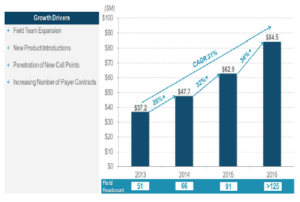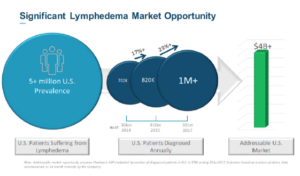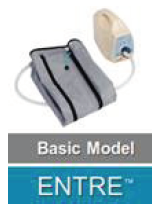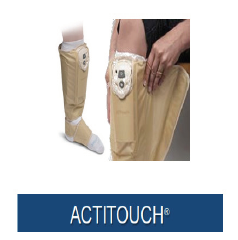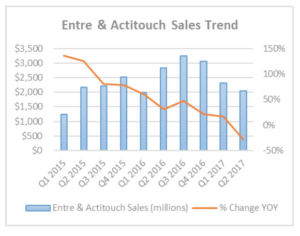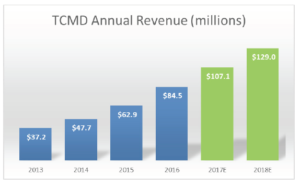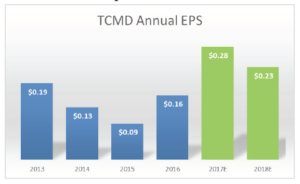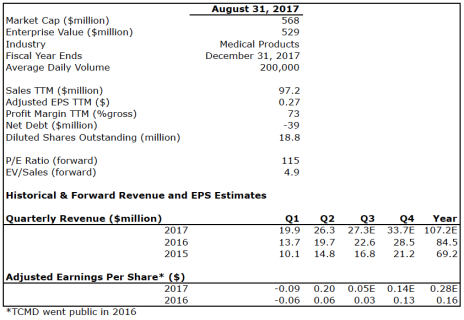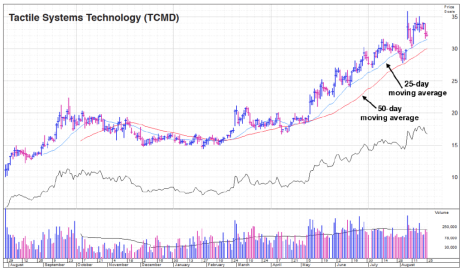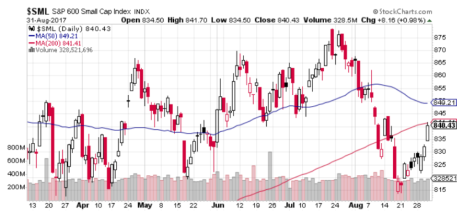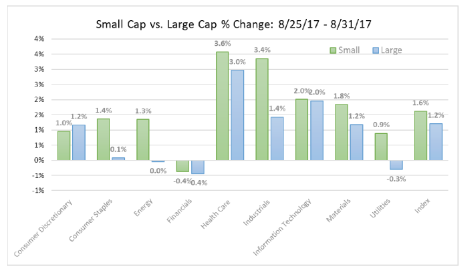Today’s candidate provides at-home health care solutions to people with vascular disease. These are often chronic conditions, which account for up to 80% of every healthcare dollar spent in the U.S. The company is growing quickly, with average annual growth since 2013 is over 30%!
Cabot Small Cap Confidential 220
[premium_html_toc post_id="138150"]
THE BIG IDEA
A few months ago, my wife Jenni injured her back and was unable to get to the doctor’s office. Thankfully, we tracked down a highly recommended chiropractor, and he made a house call within 24 hours. After three days and three sessions at our home, her sacroiliac joints (SI joints) were where they were supposed to be, and she was back on her feet.
One of the few positives from the whole experience was that it highlighted an ongoing trend in medicine that’s been increasingly on my mind. It’s one in which we have some exposure in Cabot Small-Cap Confidential, but we’ll have more exposure after today.
That trend is home health care, which covers a lot of things, from short-term treatment and physical therapy, like helping Jenni recover from her back injury, to long-term care managing chronic conditions like diabetes and cardiac arrhythmias.
The forces behind the trend are big, powerful and durable. That’s because home health care addresses big challenges, like providing better care for aging populations, keeping a lid on spending for chronic conditions—which account for up to 80% of all health care spending—and reducing clinic and hospital visits, which also helps curb costs.
It also helps many people live better, avoid inconvenient and repetitive trips to the doctor and therapist, and in a lot of instances, results in better long-term care for their condition.
Credit is due to advances in technology—medical devices, software and communications platforms—for much of the progress in home health care. But credit is also due to policy-makers and payors who are gradually improving reimbursement rates for at-home care. They’re not where they should be just yet, but they’re headed in the right direction.
All in, it’s estimated that the global home health care market was valued at nearly $230 billion in 2015, and that it will reach almost $400 billion by 2021. That implies average annual growth of 9.4%. That’s a very big market. And the outlook is particularly good for testing, screening, monitoring, therapeutic and mobility care services.
We already have exposure to one company that’s benefiting from the trend. That’s BioTelemetry (BEAT), which specializes in mobile cardiac telemetry (MCT) monitoring.
Today, we’re jumping into another.
This month’s Cabot Small-Cap Confidential candidate specializes in at-home treatment for lymphedema, a vascular disease in which the lymphatic system fails to work properly. It has a life altering product, and what appears to be a lucrative business model. Not only is the company making life better and more convenient for people with this chronic condition, it’s growing revenue by over 30% annually in the process.
THE COMPANY/PRODUCT
Tactile Systems Technology (TCMD) has developed a range of medical devices to deliver at-home care for patients with vascular disease. Its current priority is to advance the standard of care in treating lymphedema and chronic venous insufficiency (CVI), both of which are costly and lifelong conditions affecting 4.5 million to 6 million people in the U.S. Together, these two end-markets are estimated to be worth more than $4 billion a year.
Traditional treatments for Tactile’s primary market, lymphedema, include therapist massage to help drain lymph fluid, decongestive exercises, skin care, and compression with multilayered bandages. Therapy usually begins with three to five clinic visits per week, for one to two months. This is expensive, time consuming, and very inconvenient for patients, many of whom have a difficult time getting around. Plus, reimbursement often ends after two months, leaving patients with a chronic condition to self-administer care at home. This system doesn’t make a lot of sense.
To better address the market’s needs for lymphedema, Tactile has developed the Flexitouch System, a pneumatic pump that integrates with form-fitting garments that are worn by the patient. When turned on, the Flexitouch system mimics the clinic-based manual lymphatic drainage therapy. And treatment can be completed at home.
Tactile is purely a U.S. growth story today, but that will likely change within a couple of years. Recently, Tactile Systems was granted a CE Mark for the Flexitouch System in Europe, and was granted a license to sell the system in Canada. It is currently seeking CE Mark approval for its ACTitouch system (for CVI).
Management estimates that since 2004, over 65,000 patients have been treated with the Flexitouch System, and an additional 17,000 have been treated with its secondary products, ACTitouch (CVI) and Entre (lymphedema), since its launch in 2013. Flexitouch is the clear breadwinner for Tactile, and accounts for 85% to 90% of sales.
The company has a market cap of $570 million and is based in Minneapolis, Minnesota. It went public on August 2, 2016 at $10 per share, and the stock has been a strong performer since.
Tactile Systems is in growth mode, hiring sales people and rolling out new and improved versions of its devices. Annual revenue growth has averaged 31% since 2013, and is up 38% through the first half of 2017. The company is profitable, earning $0.16 per share in 2016, and is expected to grow EPS to $0.28 this year.
It has been expanding its sales force rapidly to capitalize on the market’s (both patient and clinician) increased awareness of lymphedema and its treatment options. At the end of 2015, it had 91 sales people. That expanded by 37% (to 125) in 2016, and is on track to grow by 20% in 2017 (current count is over 145). The company wouldn’t grow its sales team this quickly if management didn’t see significant, near-term opportunities.
A Crash Course in Lymphedema and Chronic Venous Insufficiency
Lymphedema
Of Tactile Systems’ two end-markets, lymphedema is the bigger, and has driven over 85% of revenue in recent quarters. Commissioned data analysis over the last three years (at 18-month intervals) suggests around five million people in the U.S. suffer from lymphedema, that that the number of patients diagnosed annually has been rising around 20% per year. Based on this data, Tactile believes lymphedema represents a $4 billion potential market, which implies that it receives $4,500 to $5,000 for each Flexitouch System.
What exactly is lymphedema? The lymphatic system helps people stay healthy by balancing fluids and regulating immunity. It does this with help of lymphatic structures (vessels, lymph nodes and lymphoid organs) that act as the body’s drainage system. You have lymph nodes under each arm, at your hips, and in your groin, neck, abdomen, tonsils and spleen. You also have them in your bone marrow. When working properly, the system collects protein rich lymph fluid and sends it in to the venous system, flushing out harmful bacteria, viruses and waste products.
Unfortunately, the lymphatic system doesn’t always work properly, and lymph fluid doesn’t drain as it should. This is when lymphedema can occur, which is marked by chronic swelling (edema), usually of the arms, legs, neck and/or torso.
There are a variety of ways a person’s lymphatic system can get damaged. Problems typically start with damage to either lymph nodes or lymphatic vessels, usually from surgery (often to remove breast or other cancers), infection, scar tissue formation, trauma, obesity or chronic venous insufficiency. Some people are just born with a faulty lymphatic system.
It is a progressive condition that can be both physically and psychologically devastating. It can become hard for people with lymphedema to move, skin can break down, it can be painful, and the chance of serious infection is higher for those afflicted.
Unfortunately, there is no cure for lymphedema. The current standard-of-care is four to six weeks of therapist massage and bandaging at a clinic, which helps stimulate lymphatic drainage and reduce swelling. As I discussed earlier, this is a costly and inconvenient way to treat lymphedema, and reimbursement usually runs out after two months. Tactile Systems offers a much better way to treat the condition.
Flexitouch
The Flexitouch system is a fully-automated and programmable pneumatic compression device that can be used at home by patients with lymphedema and nonhealing venous leg ulcers. The device mimics manual lymphatic drainage therapy, and is clinically proven to stimulate the lymphatic system, reduce swelling, and decrease hospital and therapy visits.
The system consists of an electronic controller unit, with 17 treatment settings, and a number of contoured garments that fit on various parts of the body, including the leg, arm, torso, chest, head and neck. The controller is a pneumatic compressor with four connector outlets, each of which has eight outflow ports that connect to the garment’s hoses. The garments contain up to 32 air chambers, are made of pliable fabric, close with hook-and-loop fasteners, and come in a variety of sizes.
When the controller is turned on, air passes through the hoses and sequentially inflates and deflates the garment, thereby applying gentle pressure to the skin. The process stimulates the lymphatic system and moves lymph fluid from impaired areas toward healthy areas of the body, where it can be properly processed. A typical therapy session lasts for one hour, and the system is relatively lightweight and portable, making it convenient for at-home treatment.
Flexitouch first received FDA approval in July 2002. An improved model was approved in October 2006, and in June of this year, the third generation Flexitouch Plus was approved. This latest iteration has a seven-inch color display, is able to create and save therapy programs, and can treat two limbs simultaneously, which cuts treatment times in half for many patients. There will be limited market release of Flexitouch Plus later this year, with a full commercial launch in early 2018.
The other big news is that in September 2016 Flexitouch received FDA clearance to treat head and neck lymphedema (HNL). It is now the only compression device on the market for HNL, which represents a significant market for a company of this size.
Recent data from Vanderbilt suggests that over 75% of the roughly 400,000 patients in the U.S. with head and neck cancer developed lymphedema. That works out to a target market size of 300,000 patients. Assuming a reimbursement rate of $4,670 per system, Tactile sees a $1.4 billion market opportunity.
The HNL product launched with a limited release to 80 patients in May. Tactile Systems said 88% of these patients reported a reduction in head and neck swelling, and 89% reported improvement in other symptoms, including swallowing, range of motion and discomfort.
On the Q2 conference call, management sounded very upbeat on the potential for HNL. The product is scheduled for a full commercial launch early next year.
Flexitouch typically accounts for 85% to 90% of total sales. But that increased to 92% in Q2 2017 due to the sales team’s greater focus selling the product (instead of ACTitouch and Entre). Growth of the Flexitouch system has historically been very strong (see chart above), surpassing 30% per quarter since the beginning of 2016. Management says that 16,000 units shipped in 2016, and it sees Flexitouch growing in the 29% to 32% range for full-year 2017. The product is approved in the U.S., Canada and the EU.
Entre
Entre was introduced in 2013 and is a basic, lightweight and portable pneumatic compression solution. It is designed for patients who need treatment for lymphedema and CVI, but who don’t yet qualify for insurance coverage of Flexitouch. The system includes a pump, and garments for the arm or leg. Garments have eight chambers that inflate in sequence, remain inflated for a preset time, and deflate all together. This mechanized compression system helps push fluid from the fingers and toes toward a patient’s torso. Tactile Systems began deemphasizing sales of the Entre system in the most recent quarter given that the market opportunity for the Flexitouch is so much larger, and the payback per sales rep is far superior.
Chronic Venous Insufficiency
Chronic Venous Insufficiency (CVI) represents a significantly smaller market than lymphedema for Tactile Systems, but the treatment is similar, and Tactile’s underlying technology addresses the market need with few alterations. Plus, the condition can lead to lymphedema, so there is a natural fit for the company to address this market.
The condition occurs when the venous wall and/or valves in the veins aren’t working effectively. This can make it difficult for blood to return to the heart, or even flow backward. The resulting pressure, stretched and dilated blood vessels, and collecting of blood in the veins can cause painful, slow-healing wounds in the lower leg, which are called venous leg ulcers. If left untreated, these ulcers can become infected. Prolonged and untreated CVI can damage the lymphatic system. The disease is most common among obese or pregnant patients, and can also be caused by high blood pressure, trauma, lack of exercise and smoking.
Tactile System’s analysis of claims data shows 1.5 million people were diagnosed with venous leg ulcers in 2014. The company says 30% to 40% of those were eligible for device reimbursement since their condition wasn’t resolved after six months of treatment. This target market works out to roughly 525,000 patients a year. Tactile says the addresable market is around $580 million a year, which implies it’s getting $860 for each ACTitouch system it sells.
ACTitouch
Tactile Systems acquired the ACTitouch system in September 2012, received FDA clearance in June 2013, and began selling the product in September 2013. It is designed for patients suffering from venous leg ulcers, for which the standard-of-care is sustained compression with multilayered bandages. That’s an inherently limited and very basic approach, and it doesn’t work for many patients. In contrast, ACTitouch is convenient to use, and has been shown to effectively reduce edema and heal venous leg ulcers. Like Flexitouch, ACTitouch relies on pneumatic compression to apply varying degrees of compression, typically to the lower leg, ankle and foot.
The system consists of a control unit, a compression sleeve, an under-sock (to wick perspiration), and a power adapter/charger. The compression sleeve has four chambers, attaches with hook-and-loop fasteners, and can usually be worn under clothes and with most shoes. This sleeve conceals the control unit, which monitors and adjusts pressure, and includes a treatment tracker to help patients meet treatment goals. The control unit also monitors leg circumference, and adjusts pressure every 30 minutes as needed.
Since the unit can be charged, patients are free to go about their daily routines with freedom. Typical daily treatment is two hours of intermittent compression while seated, or 10 hours of sustained compression if up and about. Recharging the unit can be done at night.
Tactile Systems reports revenue for ACTitouch and Entre in one category. Historically, the products have accounted for 10% to 15% of revenue, and sales of the two were up by 37% in 2016. However, the pace of growth has slowed almost every quarter since launch, and combined sales for the products fell by 28% in Q2 2017. That sounds like a significant decrease, and it is in percentage terms. But in dollar terms, the reduction amounted to only $780,000, and it was more than made up for with growth in Flexitouch.
According to management that’s no accident—the underlying reason for the decline is that there is greater growth potential in the higher priced, and higher profit margin, Flexitouch System. So that’s what the sales teams are being incentivized to sell. That makes sense, but in future quarters, I would like to see sales for ACTitouch and Entre separated so we have a better idea of the trends within each product.
Clinical Evidence Suggests Better than Standard-of-Care
Do Tactile System’s devices work? Naturally, this is a very important question to answer positively! And the answer is yes, at least according to 14 studies in which over 1,400 patients have worn Tactile System’s devices.
One of these studies, which was published in the American Medical Association in JAMA Dermatology, found significant improvement in key clinical endpoints and cost reductions for 718 patients with lymphedema (and insurance) that used Tactile System’s Flexitouch system. It found significant reduction in rates of cellulitis episodes (down 79%), inpatient hospitalizations (down 54%), outpatient hospital visits (down 40%), rates of physical therapy visits (down 34%) and lymphedema-related costs per patient (down 37%).
Another study, published in the European Journal of Vascular and Endovascular Surgery, showed that the Flexitouch System helped 88% of a 196-patient group reduce limb volume, with 35% showing limb volume reduction of over 10%.
And yet another study, published in Supportive Care in Cancer, focused on 36 patients and found that the Flexitouch System provided better clinical outcomes than a basic pneumatic compression device for home-based treatment of breast cancer-related lymphedema
The Business Model
Tactile Systems is a medical device manufacturer, and as such, each device must receive 510(k) clearance from the FDA. It uses a direct sales force to help push clinician awareness. Primary call points for sales people are lymphedema clinics, vascular and venous care clinics, wound care clinics, podiatrists and VA hospitals. The company has achieved extensive health insurance coverage with private payers, Medicare (10% of revenue), the Veterans Administration and certain Medicaid programs. Management estimates that over 270 million lives in the U.S. are covered by in-network provider contracts.
All products are manufactured and initially assembled by third-party contract manufacturers. Final assembly, testing and shipping is completed from Tactile Systems’ facility in Minneapolis. Revenues are somewhat seasonal (lowest in Q1 and ramping up through Q4) due to co-pays and deductibles. That said, as business with Veterans Affairs (VA) hospitals ramps up, this is changing since there are no deductibles for veterans.
The company has a somewhat rare marketing business model in the medical device field, called a direct-to-patient and direct-to-provider model. This means Tactile Systems bypasses the traditional durable medical equipment (DME) channel, and works directly with patients and clinicians. In other words, it bills and collects directly from payers and patients (through co-payments). Patients are reimbursed by government and private payers based on established rates negotiated with each payer. Management says this model results in higher profit margins (gross margin in the first half of 2017 was 73%), better customer service, and higher payer approval rates (currently at record levels, in excess of 85%). It also says these high profits help fund R&D.
The tradeoff is that the company needs to employ more people to handle the role that a DME typically would. It has an internal reimbursement operations group of 75 people to verify case-by-case benefits, collect payments and provide customer support. It also has a payer relationship group of 25 people to cultivate insurance payer relationships, educate them about product efficacy, and develop coverage policies and reimbursement criteria. Then there is an internal clinical team consisting of a scientific advisory board and in-house therapists and nurses. Lastly, Tactile Medial sub-contracts out to roughly 400 licensed, independent healthcare practitioners to work as home trainers to educate patients on proper use of its systems.
I think the model does help Tactile Systems achieve its goal, which is to have a more robust business model that gives it a competitive advantage. To displace Tactile, competitors not only need to build a better mousetrap, they also need to convince a large number of clinicians to change suppliers. That’s probably a bigger hurdle than garnering the business of a few durable medical equipment providers. Additionally, management says competitors need to meet national accreditation and state-by-state licensing requirements, as well as secure Medicare billing privileges—some good-sized hurdles.
The Bottom Line
Tactile Systems has been averaging 31% annual revenue growth over the past four years, and growth has been accelerating. In 2016, revenue grew by 34%. It expanded by 38% in the first half of 2017, including 34% revenue growth in Q2.
On the conference call, management upped its full-year growth outlook to a range of 24% to 27% growth, which seems very conservative given that the increase only reflects the $2 million second-quarter beat.
I think 30% revenue growth in 2017, to $110 million, is very attainable. The company has been expanding its sales force, and that’s been a major growth driver. At the end of 2016, it had 125 sales people. Management said it would expand the salesforce by 20% in 2017. It’s making progress; at the end of June it was up to 145.
My bullish outlook assumes the sales team continues to be successful selling the Flexitouch System, and that Tactile’s increased contractual coverage with national and regional insurance payers continues to be smooth. I also believe that, given that Tactile Systems is now in 140 of 180 Veterans Affairs (VA) hospitals, and there is no reimbursement risk with these accounts, that its revenue base is increasingly dependable. Upside could come from adding some of those remaining 40 VA hospitals, or expanding sales within the current base. That said, business with VA hospitals has helped contribute to some of the growth in the first half of the year. We’ll just have to see if this additional revenue persists in the back half.
Profitability is a little more challenging to forecast given that Tactile Systems just went public last year. There are usually items affecting profitability that take some time to work through the income statement (public company costs, taxes, stock based compensation expense, etc.). Reported EPS was $0.16 in 2016, and is estimated to grow by 75% to $0.28 in 2017 (the firm earned $0.11 per share in the first half of the year). Current analyst estimates are calling for EPS of only $0.23 in 2018, which implies an 18% contraction from 2017. I need another quarter or two of results to better understand where EPS could be in 2018, and I suspect other analysts following the company do as well. Therefore, don’t focus too much on current EPS estimates for 2018. I’ll update them toward the end of this year.
The bottom line is that there are multiple internal initiatives driving growth for Tactile Systems. It is growing the number of patients eligible for benefits by expanding its base of in-network providers. It has a growing and increasingly productive sales force, motivated by a new compensation system, that is targeting the top 30% of clinicians diagnosing lymphedema in the U.S. It has hired dedicated people to help drive greater sales within VA hospitals. It also has new products hitting the market, most importantly Flexitouch for head and neck. All of these initiatives should help the company grow revenue well above 20% for several years.
RISK
Patent Expiration: Flexitouch’s last current patent expires this year. This is a potential risk, although with new products/versions hitting the market, it’s likely that Tactile Systems will refresh its IP protection. To that end, it has seven utility patent applications, and four design patent applications filed for the Flexitouch System in the U.S., as well as six international utility patents and eight national/regional design applications. For its other solutions, it has seven patents pending in the U.S. (17 issued) and four pending outside the U.S. (60 issued).
Vendor Reliance: In the six months ending June 30, 2017, 36% of Tactile Systems revenue came from its top three vendors. That’s not a huge number, but it’s not insignificant. Any breakdown in the relationship with one or more of these vendors would leave a sizeable hole in revenue.
Medicare and VA Reliance: In the six months ending June 30, 2017, 10% of revenue came from Medicare and 18% of revenue came from VA hospitals. These are significant amounts, and while all appears fine at the moment, it’s worth making a mental note.
Rental Business: Recently, one payer switched to renting Tactile System’s devices. That means revenue is divided up into the rental period. Traditionally, rentals have accounted for around 10% of total revenue. Now, they account for “mid-teens,” according to management. It doesn’t sound like this is a major trend, but it’s worth keeping an eye on since we don’t know exactly how increased rental demand would change the revenue growth trajectory (if at all).
Contraction in Sales of ACTitouch and Entre: I understand why sales for these products have declined. But I’m also surprised by the size of the decline (28%) in Q2. I spoke with the CFO (through email), and she confirmed my assertion that Tactile is “giving up” some sales on these products in order to focus on Flexitouch. And she pointed out the size of the opportunity there. Again, this makes sense. And there should be a product refresh for ACTitouch coming to help rejuvenate that product. Still, I don’t like to see declines in any category, so I’ll continue to monitor this trend.
COMPETITION
Tactile Systems competes with a number of manufacturers and distributors of pneumatic compression pumps. Its largest competitors are Bio Compression Systems and Lympha Press (owned by Mego Afek). Smaller competitors are Wright Therapy Products (acquired by BSN Medical GmbH in 2015), Devon Medical Products and NormaTec Industries. A potential international competitor is ArjoHuntleigh, should Tactile push a big international expansion effort.
THE STOCK
Trading Volume: Tactile Systems has a market cap of $570 million and trades an average of 200,000 shares daily. That said, most days it trades under 200,000 shares, but the average has been pulled up by a dozen big volume days over the past six months (all but one of which were up days). Still, our subscriber group shouldn’t move this stock. Heavy days are +400,000 shares, and that’s happened eight days in the last six months.
Historical Price: TCMD went public on August 2, 2016 at 10. The stock was hot right out of the gate, and rallied up to 22 in September before things cooled off. Lower demand caused shares to retreat to around 14.5 in January, and the stock formed a base near the 16 level that lasted until the end of February. A better-than-expected Q4 report on February 27 caused shares to gap back up above 21. After a few months of choppy trading action, and the May 8 release of Q1 earnings, TCMD began a sustained rally that carried it to 31 by mid-July. There was a little dip to the 50-day line at 28 in early August, but another better-than-expected quarterly report on August 7 pushed shares to a fresh 52-week high of 35.79. For the past four weeks, TCMD has been consolidating in the 31 to 34 range.
Valuation and Projected Price Target: With a market cap of $570 million, no debt and $39 million in cash, Tactile Systems has an enterprise value of roughly $530 million. Based on consensus estimates (which I believe are too low), shares are trading with an enterprise value-to-2018 sales ratio (forward EV/sales) of 4. That’s not cheap, but there’s room for multiple expansion. Let’s assume Tactile Systems hits 27% revenue growth in 2017 (I believe it will do even better), and grows by 24% in 2018 and 2019 (4% above consensus, which seems very doable to me), then shares could be trading 50% higher a year from now and carry a forward EV/sales ratio of 4.8. That seems realistic to me, therefore my initial price target is 48.
Buy Range (next two months): My wide preferred buy range is between 28 and 36. That covers the range from the early-August dip to the intra-day high following the release of Q2 earnings. A more probable range to build your initial position is between 31 and 34, which contains most trading action over the past three weeks.
The Next Event: Management has no major PR events on the immediate schedule. Third-quarter earnings should be out in early November. And we should get news of a limited market release of the Flexitouch Plus product before the end of 2017, with full commercial launch announcements for both Flexitouch Plus and the HNL system in the first half of 2018.
Tactile Systems Technology (TCMD) Financials
Tactile Systems Technology (TCMD 33) |
UPDATES ON CURRENT RECOMMENDATIONS
Due to the nature of the stocks recommended, it is to your advantage not to share these recommendations.
Strong Buy means the stock should be bought immediately and is expected to move sharply higher in the very near future.
Buy means accumulate shares at or around the current price.
Hold means just that; hold what you have. Don’t buy, or sell, shares.
Sell means the original reasons for buying the stock no longer apply, and I recommend exiting the position.
Sell a Half means it’s time to take partial profits. Sell half (or whatever portion feels right to you) to lock in a gain, and hold on to the rest until another ratings change is issued.
The market is looking much better this week. The S&P 600 Small Cap Index has made a very healthy looking move off support at 815 to rally back to its 200-day line at 840.
This action suggests the latest wobble was just that, and not a signal that a larger decline is looming. But, with many stocks still damaged following Q2 earnings reports, I think investors are licking a few wounds. It’s probably a good idea to put a little money to work here, especially in leading stocks like Tactile Systems (TCMD)! You can also dip a toe into a few rapidly recovering stocks. But, go slow and don’t overdo it—things could still turn south quickly.
But let’s stay positive heading into the long holiday weekend. Over the past week, we saw almost all sectors head higher, led by health care, industrials and tech. In most sectors, small led large, which implies investors are once again willing to take on a little risk (a bullish sign).
Most stocks in our portfolio moved higher too, with the notable exception of Primo Water (PRMW).
There are very few fundamental developments to report on over the past week, meaning I’m mostly looking at charts and commenting on share price action.
Updates
Airgain (AIRG) enjoyed a jump after last week’s share buyback program was announced. After a little wobble, shares are almost back to their post-announcement level. It’s impossible to know how much of the current volume is being driven by the buyback (if any), and how much by other investors who think the program will help shore up the struggling stock. In any event, we’re still staying on the sideline. SOLD.
AppFolio (APPF) is back on the move higher after pausing around the 42-level last week. There’s no new fundamental news to report. Shares of the property management software provider just continue to be in high demand following another strong quarter, with better than expected profit margins. BUY.
Asure Software (ASUR) was moved to Hold last week after it dipped near our buy point, which happened to be just below the 200-day moving average. Shares have enjoyed a couple of good days on the back of broad market strength, but the general trend here is still weak. I’m keeping at Hold until the chart looks more constructive. Management will present at the Liolios Gateway Conference next week, on September 6. HOLD.
AxoGen (AXGN) had another great week and has broken above its previous high near the 17-level. It has helped that biotech stocks are rallying (Gilead’s acquisition of Kite Pharma has helped), which is contributing to significant strength in biotech stocks. You can play the trend with the SmallCap Health Care ETF (PSCH), if you’re looking for broad exposure to small-cap health care. Of course, at the moment, the bigger moves higher are being found in individual stocks, like AxoGen. Coming up next week is management’s attendance at the Annual Meeting of the American Society for Surgery of the Hand (ASSH) on September 7-9 in San Francisco. The management team moves on to Lake Street (September 13), Dougherty & Co. (September 19) and Cantor Fitzgerald (September 25). It will also host an Investor Day on November 20. BUY.
BioTelemetry (BEAT) is still looking strong and shares have remained above their 50-day line since late-June. The digital health company, which specializes in remote cardiac monitoring, is likely to grow revenue by well over 30% over each of the next two years, in part because of the LifeWatch acquisition. Shares of upstart iRhythm Technologies (IRTC) also continue to do well, suggesting there is plenty of room for multiple companies to grow quickly in the remote cardiac monitoring market. It’s going to be interesting to see if and when this turns into a dogfight given that BioTelemetry is debuting a monitor in the patch form factor very soon. This has been part of iRhythm’s claim to fame. Stay tuned… Keeping at Buy. BUY.
Everbridge (EVBG) has seen shares jump back to their 50-day line this week, potentially because of increased use of its critical communications platform due to all the rain in Texas and Louisiana. While the three-month trend is down, the stock is far from broken. Continue to hold. HOLD HALF.
Globalscape (GSB) was moved to sell two weeks ago to remove any risk that its internal investigation will get bigger and/or worse. The stock continues to reflect investor uncertainty, and at this stage, the risk of stepping back in is just too high. I’ll continue to keep the stock on my watch list. SOLD.
LogMeIn (LOGM) remains very resilient and shares of the collaboration software specialist bounced right off their 50-day line on Monday. We’re in a news flow lull given Q2 earnings were recently reported and that management gave a thorough update on the GoTo integration progress at that time. Just keep holding. HOLD HALF.
MindBody (MB) was sold a couple of weeks ago at around the current level due to persistent weakness following Q2 results. Shares took a big leg down last Friday, but have looked much better this week. Still, the current trend is down, so let’s bide our time and consider adding the stock back if and when the chart looks more constructive. SOLD.
Primo Water (PRMW) is still acting poorly and is testing its May low near 11. Provided shares of the bottled water company can hold that level, I expect to keep it at Buy. If it breaks below that, I’ll need to reevaluate. I’ve been surprised at the extent and duration of the weakness. But I also recognize that in the big picture, it’s not uncommon for good companies to see their stocks fail to move higher for several months. From April of 2014 to March of 2015, shares of Primo couldn’t break out of the 4 to 5 trading range. Then they rallied 200% over the next two years! We’re in a tricky spot given that a major acquisition was just completed and the stock’s not acting well. But it’s possible Primo itself could be sold (remember it has a relationship with Cott Corporation, which seems like a good fit to me). At any rate, I’m keeping at Buy for now. If it breaks much below 11, I’ll be forced to reconsider. BUY.
Q2 Holdings (QTWO) has been holding up nicely after breaking out to a fresh 52-week high and a new trading arrange above 40 last week. There’s nothing fundamentally new to report for the company, which provides software to credit unions and banks. And at this point, I’m not ready to move back to Buy. Continue holding your remaining shares. HOLD HALF.
U.S. Concrete (USCR) has been up and down over the past two weeks, potentially due to uncertainty over Trump’s infrastructure spending plans (including the proposed wall on the U.S.-Mexico border) and unknown impacts of flooding damage in Texas, one of the company’s biggest markets. The company is based in northern Texas, where it generates 27% of revenue. It also generates 10% of revenue in southern and western Texas. It appears that this week, concerns have been far outstripped by potential opportunities given that there’s going to be a lot of rebuilding going on in Texas after Harvey moves out. It has also helped that GDP figures were revised higher. Obviously, we’d rather that Texas didn’t get hit so hard and so many lives weren’t disrupted by the storm. But, the cup-half-full perspective is that U.S. Concrete will likely be a part of the rebuilding effort, and that’s good for shareholders. Keep holding. HOLD.
Please email me at tyler@cabotwealth.com with any questions or comments about any of our stocks, or anything else on your mind.
Next Cabot Small-Cap Confidential issue is scheduled for October 6, 2017
Cabot Small-Cap Confidential is published by the Cabot Wealth Network, an independent publisher of investment advice. Neither the corporation nor its employees are compensated in any way by the companies whose stocks we recommend. Sources of information are believed to be reliable, but they are in no way guaranteed to be complete or without error. Recommendations, opinions or suggestions are given with the understanding that subscribers acting on information assume all risks involved. Copyright © 2017 - COPYING AND/OR ELECTRONIC TRANSMISSION OF THIS NEWSLETTER IS A VIOLATION OF THE U.S. COPYRIGHT LAW. For the protection of our subscribers, if copyright laws are violated by any subscriber, the subscription will be terminated.
[premium_html_footer]


